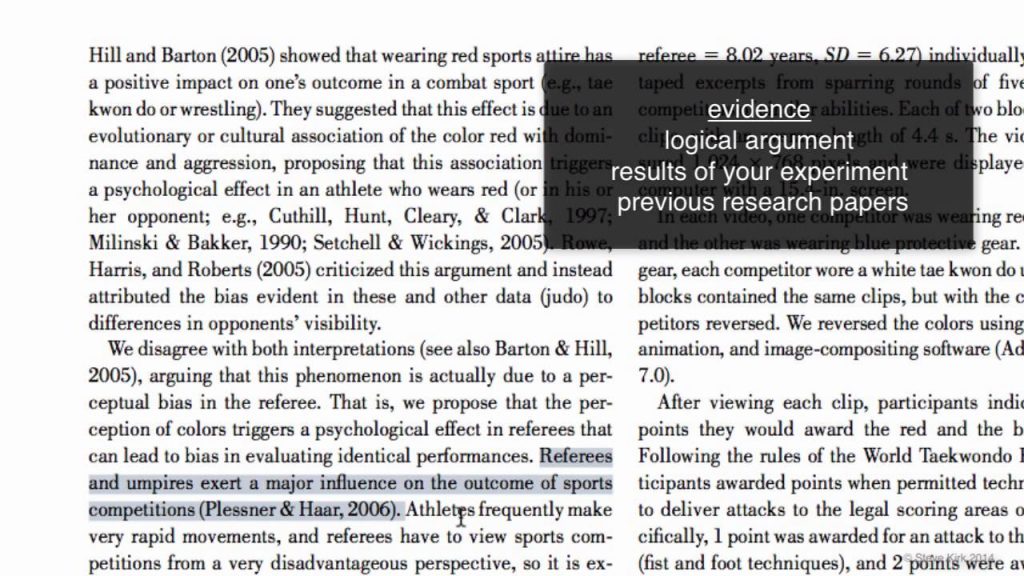原題の科学論文は一定の形式を持っており、タイトル、要旨、序論(Introduction)、材料と方法(Materials and Methods)(ジャーナルによっては最後)、結果(Results)、そして考察(Discussion)から構成されています。頭文字をとって、IMRaD (Introduction、Method、Result and Discussion)と呼ばれることもあります。順序だけでなく、各々のセクションをどう書くべきかはある程度決まっており、その原則から外れた書き方をすると、科学論文としての体をなさなくなります。以下、論文の書き方を各セクションごとに説明したYOUTUBE動画やネット上の記事を紹介します。ちなみに、研究者が論文の原稿を書くときにこの順で書き進めるというわけではありません。実際に書くときは、図表を完成させてストーリーをつくる順に並べ、本文の構成の骨組みを書き出し、それから肉付けするのがよいと思います。いきなり書き始めずに、骨組み(構想)をまず書き出す作業をすることが大事です。そうしないと書いているうちに迷走します。
目次
論文タイトル Title
論文タイトルは、論文の内容を簡潔に示したものになります。
論文要旨 Abstract
要旨には、限られた文字数の中で背景、目的、方法、重要な結果、結論、意義を含めるようにします。
イントロダクション Introduction
The Introduction to a research paper needs to convince the reader that your work is important and relevant, frame the questions being addressed, and provide context for the findings being presented. (Getting a Strong Start: Best Practices for Writing an Introduction by Michael Bendiksby) ← この文書には、科学論文のイントロの意義、イントロに含めるべき内容・事項、イントロの具体的な書き方が簡潔に述べられていて、非常に濃い内容になっています。
イントロでは、先行研究により既にわかっていること、まだわかっていないこと、自分の研究で明らかにしたいこと、実験で検証する仮説、研究の目的などを書きます。何を述べるにしても、その根拠となる文献を引用しなければなりません。
How to write the Introduction: Part 1
イントロダクションではどのようなスタイルで書くべきでしょうか?イントロは複数のパラグラフからなります。一つのパラグラフには、一つのトピックが含まれるようにし、トピックセンテンスによってそれを示します。文と文、パラグラフとパラグラフは、きちんとつながっていることが必要です。そのためには、論旨の流れを示す言葉(furthermore, howeverなど)を有効に使いましょう。事実や実験結果を示す際の、現在形、現在完了形、過去形の使い分けも重要です。
How to write the Introduction: Part 2
方法 Materials and Methods
方法のセクションは、結果の信憑性を示すためにも重要です。
How to write the Method part 1
メソッドのセクションはどのような英語のスタイルで書かれるのでしょうか?一般的に、時制は過去形が使われ、能動態でなく受動態で書かれます。
How to write the Method part 2
結果 Results
論文はストーリーです。Resultsのセクションでどのような順番でデータを見せるかにより、ストーリーの良し悪し(=論文の良し悪し)が変わってきます。
Although the fundamental purpose of your Results section is to present your data, it should never simply be a collection of numbers and tables. This part of the paper should be a story within a story. It presents an opportunity to lead the reader from one important result to the next, guiding them from initial and supporting findings to the novel discoveries that are your reason for publishing. To achieve this, the Results section should generally follow the same pattern as the Methods, following the order of data acquisition as closely as possible in most cases. However, it is more important to use a logical presentation sequence than it is to be strictly chronological. Ideally, each new set of results should build on the previous ones, presenting a logical narrative that makes sense to the reader and leads them to the conclusions you will ultimately ask them to subscribe to. (Reaping the Rewards: Best Practices for Writing a Results Section by Michael Bendiksby)
結果のセクションでは、実験で得られた結果のみを書きます。実験結果の解釈を書いてはいけません。それは議論のセクションで書くようにします。
How to write the Results part 1
結果のセクションではどのような英語表現を用いるべきでしょうか?
How to write the Results part 2
考察 Discussion
考察のセクションには、実験結果が何を意味するのかを書きます。論文執筆において最も書くのが難しい部分でしょう。なぜなら、どれほど深く考えているのか、どれくらい考えが明晰になっているのかが問われるからです。
How to write the Discussion part 1
考察のセクションは、結果のセクションで書いたことを繰り返し書く場所ではありません。
How to write the Discussion part 2
参考
- 医学界新聞プラス [第2回]IMRaDを理解する 『医学英語論文 手トリ足トリ いまさら聞けない論文の書きかた』より 堀内圭輔 2022.05.06 英語論文を書くにあたって英語力はもちろん重要ですが,それ以上に重要なのは,論文の作法や決まりごとを理解して,自分の考えを平易に説明できる能力です。‥大きな仕事でも,小さな仕事に分割し,1つずつこなしていけば,いつか終わります.英語論文も同様です.幸い,英語論文はいくつかの項目に明確に分かれており,各々の項目で書くべき内容も大体決まっています.
- Scientific writing 101 Nature Structural & Molecular Biology Feb 2010;17(2):139:論文作成のポイントが1ページで簡潔にまとめられている
- Getting a Strong Start: Best Practices for Writing an Introduction by Michael Bendiksby:イントロは何のためにあるのか、どう書くべきなのかを簡潔かつ明確に説明。
- Setting the Scene: Best Practices for Writing Materials and Methods by Michael Bendiksby メソッドのセクションをきちんと書くと、論文の信頼性も上がる。
- Reaping the Rewards: Best Practices for Writing a Results Section by Dr. Michael Bendiksby:Resultsセクションは何を目的として書くべきなのかを端的に説明。
- From Science to Citation (fromsciencetocitation.com) 論文の書き方を各セクションごとに丁寧に解説し、さらに論文投稿やエディターとのやり取りに関しても書かれています。論文の書く上で参考になる非常に良い教科書。書籍としても出版されていますが、このウェブサイトから無料でもダウンロードできるようです。
- 論文の書き方 東京農業大学生物産業学部水圏生態学研究室 October 18, 2006
- 学術論文作成の基本と英語らしい論文の書き方 (PDF 54 pages) 大島勇人 Journal of Oral Biosciences誌編集長 新潟大学大学医歯学総合研究科 2014.9.26 歯科基礎医学会学術大会総会ランチョンセミナー エルゼビア社主催 若手研究者のためのAuthor Workshop
- From Science to Citation: How to Publish a Successful Scientific Paper
- これから論文を書く若者のために 改訂第二版 1999.1.21. ver. 2.1 酒井 聡樹(東北大学大学院理学研究科生物学教室)
- Getting Published: How to Write a Good Science Paper, by Dr. Chris Mack (Editor-in-Chief, The Journal of Micro/Nanolithography, MEMS, and MOEMS)(youtu.be/yvhYTdEMyC8) 17:00- Introduction Section 18:23- Method Section 19:46- Results and Discussion Section 21:33- Conclusion Section
同じカテゴリーの記事一覧
- 科研費の採否はここで決まる!研究計画調書(申請書)の書き方~項目別実践的攻略ポイント~
- 蓮舫氏「2位じゃダメなんですか?」発言の真相:切り取られて作られた報道
- 科研費が採択されない人の特徴
- 論文を書き始めることができないんですけど?
- 科学論文で使える英語表現、語句、英単語
- 英語論文の書き方:文と文とをつなげる
- 利根川進博士のぶっちゃけ話:研究者として成功できた理由および成功戦略
- 東北大学の女性限定教授公募の波紋「教授って合コンサークルか何かなのか?」
- 数量化1類、数量化2類、数量化3類、林知己夫の数量化理論
- 大学教員を目指す公募戦士の戦い方、デキ公募という難敵の回避方法など
- 研究の行き詰まりを打開する18のアイデア
- 【科学英作文】useを使うかutilizeを使うか?使い分けの考え方
- 生命医科学研究領域の論文出版数で測った日本の大学の研究力ランキング
- 科研費に採択されるための教科書と副読本、厳選5冊
- ラボは何時間労働?ボスからの手紙
- 研究者にとっての論文十ヶ条
- この2つを意識するだけで作文能力が劇的に上がる:cohesion(連結)とcoherence(首尾一貫)
- 科研費が不採択だったら、開示された審査結果を分析して改善点を探そう
- ただいま「所属研究機関処理中」2020年度(令和2年度)4月1日午前10時00分、科研費交付内定が通知される
- 大学における第3の職種URAとは?科研費獲得増の効果は?
- 臨床医のための 臨床研究テーマの見つけ方
- 科研費は基盤Aか、手堅くBか、審査区分は?
- 科学研究費助成事業公募要領等説明会(文部科学省・日本学術振興会主催)が開催される
- 「3た」論法とは
- まだ紙の実験ノート使って研究してるの?【電子実験ノートの浸透】
- 実験ノートの書き方
- 実験におけるポジコン、ネガコンの重要性【研究の基本的な作法】
- 平成22年度(2010年度)科学研究費補助金 新学術領域研究(研究提案型)に係る事後評価報告書(最終報告書)
- 平成23年度(2011年度)科学研究費補助金 新学術領域研究(研究提案型)に係る事後評価報告書(最終報告書)
- 平成25年度(2013年度)科学研究費補助金 新学術領域研究(研究提案型)に係る事後評価報告書(最終報告書)
- 平成24年度(2012年度)科学研究費補助金 新学術領域研究(研究提案型)に係る事後評価報告書(最終報告書)
- 【変わる科研費】新学術領域研究を見直しへ~制度の主な変更点~
- レジデントノート2月号(2019年)の特集「学会発表にトライ!」
- 効果的な科学プレゼンテーションをつくりあげる方法
- 英文校正業者の選び方と英文校正の利用の仕方
- 2019年4月1日科研費の採択が通知される
- 医学系の学術雑誌インパクトファクター 2018ランキング
- ImageJインストール方法と使用事例
- 今まで誰も教えてくれなかった「人前で話す極意」鴨頭嘉人 (かもがしら よしひと)の話し方教室
- 成功するジョブトーク(面接セミナー)のやり方
- アカデミアでの推薦状の書き方と文例(英・日)
- 生命科学研究者にお勧めの新刊・既刊
- 研究者のための科学英語プレゼントレーニング大学院講義
- 平成31年度科研費採択を目指し計画書を書く(ง •̀_•́)ง‼
- Research Statementの書き方
- 論文執筆時の注意点:曖昧さの排除
- 論文数世界ランキングで日本は6位に後退
- 大きな差を生む小さな習慣:実験ノートの効果的な書き方
- 手段はusingかby usingかbyかwithか?
- あなたが論文を書けない理由がわかる40の質問
